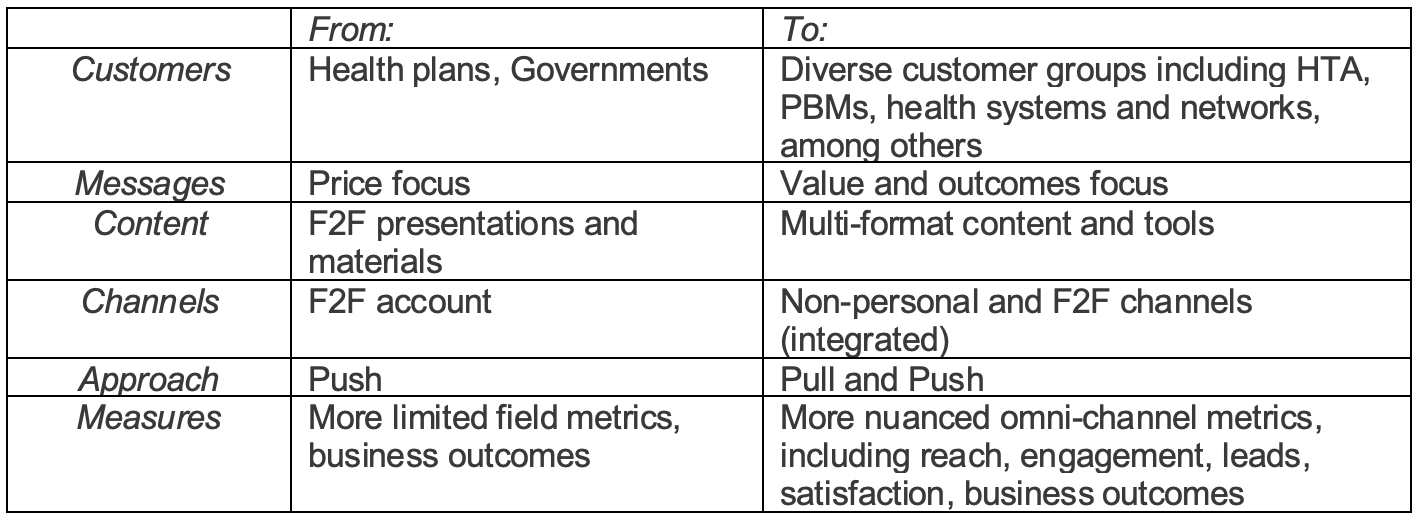Biopharma Market Access: The Pivot to Payer Omnichannel Engagement
The adoption of digital channels for patient and healthcare provider (HCP) engagement has been a growing priority for global and US brand teams for years now. Digital payer engagement was largely an afterthought even though accessing payer audiences has never been easy.
With Covid, we’ve seen an uptick in interest from Global and US market access teams for an omnichannel approach that integrates non-personal and digital strategies & tactics into Pharma payer engagement plans.
This shift is a logical response to changing payer dynamics and the presence of new channel options for targeting, reaching, and engaging payer audiences which we have refined at The Stem.
Gregg Fisher, Managing Partner, The Stem

Virtual engagement
Research we commissioned in 2019 (pre-Covid) demonstrated that payers across markets use a range of digital information sources to support their decision making and to keep abreast of medical news1. They spend roughly half their day on digital activities, including email, researching online, or using apps. And they appreciate value-added information and tools from Pharma. In short, Payers wanted a more multi-channel approach from Pharma well before Covid but weren’t getting it.
Covid only heightened Payer demand for virtual interactions by constraining the physical access that market access account teams had with their customers. This accelerated the teams’ need for skillful use of digital content and channels, both face-to-face virtual and non-personal, to expand reach and frequency of interactions.
Focus on value and outcomes
Payer marketing has shifted from purely a cost negotiation to a conversation around value -- health system cost savings coupled with added clinical benefit and improved health outcomes. The pressure to demonstrate value and cost effectiveness has only grown in response to payer consolidation, public and government cost scrutiny, and growing product competition. This has prompted the need for payer marketers to disseminate value-added content and tools (both branded and unbranded content) to differentiate a brand’s value proposition.
Varied customer segments
With the focus expanding beyond price to value and outcomes, payer marketers now need to consider the needs and priorities of distinct stakeholders, including price, value, and outcomes-focused decision making, across pharmacy benefit managers and insurance companies, health systems, physician networks, advocacy groups, and governmental agencies. Once these distinct segments are understood, content interactions can be tailored accordingly.
Omni-Channel approaches that communicate a product value story for Health Technology Assessments (HTAs) need to take into account new and emerging measures, endpoints and methodologies for assessing added product benefit. Top of mind for national, regional and local payers is budget impact.
Payer Digital Engagement Opportunities
The implication of these market dynamics is that market access/payer marketers must evolve from the traditional approach of presenting payer value proposition decks at face-to-face meetings to a more sophisticated omni-channel approach that delivers cost, value and outcomes information packaged in varying formats. The value story can be customized and tailored to distinct customer groups, through a variety of different, yet integrated, personal and non-personal channels. The impact of this evolution will be a richer “pull and push” engagement with key decision makers at relevant points in their journey that can be measured in terms of reach, engagement, leads. and ultimately business outcomes.
Evolution of Payer Engagement

Execution Considerations
As market access teams embark on the pivot to omni-channel customer engagement, below are some tips to consider based on our experience in pioneering innovative omni-channel strategies for global and US market access teams.
Design customer-centric content
Market access teams can draw important lessons from the experience of commercial sales reps during Covid on how to engage customers in a virtual environment.
One of the key lessons is that virtual engagement requires valuable “customer-centric” content to capture customer attention, otherwise customers will choose not to engage. The conversation must start with content tailored to the customer's priorities and the channels must be appropriate for that narrative.
Think in terms of a customer-engagement funnel, rather than one-off F2F interactions
Use one channel to direct payer customers to another channel that deepens engagement and personalization. This can take different forms. For example, use anonymous non-personal digital channels to get customers to opt-in to face to face virtual events where they can be identified. Then, use these events to open the door to an Account Director interaction, and follow up that interaction with personalized email or digital F2F contact. Measure customer reach, engagement, leads, and behavior change across the funnel.
Vary content formats and build tools
Beyond simple presentations, experiment with a variety of interactive formats to deliver a cohesive, compelling narrative and appeal to different learning styles. Effective content formats to consider for payer marketing include videos that bring outcome and value messages to life through the voices of provider and patient influencers, infographics that tell a complex value story simply and curation and summaries of journal reprints. Interactive cost tools tailored to individual institution parameters are another highly effective interaction format. Finally, content about company-sponsored digital health services, whether they are digital therapeutics (medical devices) or beyond the pill patient or HCP support programs, can be highly effective in bolstering a brand’s value and outcomes story, by demonstrating the link between the product, the digital health service, and patient outcomes.
Leverage new, highly targeted non-personal channels
We have found LinkedIn and Google to be effective tools for targeting payer and HTA audiences with content--not just in the US but globally as well2. Content discovery engines like TrendMD can be impactful in promoting journal content in contextually relevant contexts. Re-targeting firms can reach payer decision-makers by mapping the IP address of computers to the physical location of institutions. Email list suppliers,industry congresses, societies and journals can help reach specific payer job titles. Webinars are well-suited to driving depth of education. Product information can be delivered through portals like Xcenda and Formularydecisions.com3. These are just a sampling of the channel options available.
Conclusion
While payer marketing has historically lagged health care provider and patient marketing in adopting omni-channel customer engagement, that’s changing driven by Covid, shifts in industry and customer dynamic, digital payer behavior and the growth of relevant digital channels. To maximize success, market access teams should aim to build a “customer-focused” content plan that is aligned to diverse customer segment priorities around cost, value and outcomes. That content should be packaged in a variety of immersive formats aligned to customer, message, and channel. To maximize reach and engagement, content should be orchestrated across channels, with the goal of moving the customer through an engagement funnel to educate and inform their decision making.
Gregg Fisher, Managing Partner, The Stem | gfisher@thestem.com
1 The study referenced is proprietary to clients, however evidence of this shift has been documented in the public domain since 2017. For example, see this report: https://clarivate.com/blog/pharmas-approach-to-market-access-facing-digital-disruption-study-finds/ .
2 Experience drawn from 2020 unbranded global payer engagement campaign.
3 https://www.formularydecisions.com/global/dynamic.aspx
The Misinformation Maze: Navigating Public Health in the Digital Age
March 11th 2025Jennifer Butler, chief commercial officer of Pleio, discusses misinformation's threat to public health, where patients are turning for trustworthy health information, the industry's pivot to peer-to-patient strategies to educate patients, and more.
Navigating Distrust: Pharma in the Age of Social Media
February 18th 2025Ian Baer, Founder and CEO of Sooth, discusses how the growing distrust in social media will impact industry marketing strategies and the relationships between pharmaceutical companies and the patients they aim to serve. He also explains dark social, how to combat misinformation, closing the trust gap, and more.